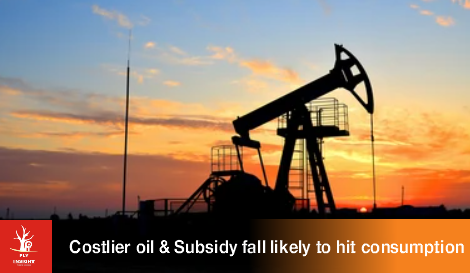
Costlier oil & Subsidy fall likely to hit consumption
- मार्च 10, 2022
- 0
The 2022-23 fiscal year could be tough for companies in consumer demand-related sectors, because of multiple headwinds, including cut-back in subsidies, higher oil prices, and rising interest rate.
The biggest headwind to the consumption story in FY23 is a sharp decline in government subsidies on food, fertilizer and fuel, and overall decline in revenue expenditure net of interest payments. This, analysts say, will adversely impact purchasing power of households at the lower end of the income pyramid, translating into lower spending on consumer goods & services.
The Union Budget for 2022-23 has proposed a 26.6 per cent year-on-year decline in subsidy on food, fertilizer, and petroleum to R3.18 trillion in FY23, from R4.33 trillion in FY22. Besides, It has been decided to cut the allocation for the rural employment guarantee scheme by 25.5 per cent in FY23 to R73,000 crore from revised spending of R98,000 crore during FY22.
“The impact of Budget measures will be felt the most in rural areas where subsidies are a key component of household cash income. A cut in food and fertilizer subsidies and lower allocation for the employment guarantee scheme will hit per capita income in rural areas, resulting in lower demand for staples and low-end consumer items.
A cut in subsidy is coming at a time when households face higher cost of living because of a sharp rise in fuel and commodity prices. The average price of Brent crude oil is up 71 per cent in FY22 over FY21, leading to higher energy and transport cost. The rise in crude oil price also pushes the cost of fertilizers and farm inputs.
“The recent rise in crude oil prices will lead to higher inflation, forcing households to defer discretionary spending as they save cash to pay for essentials, such as food, travel, and utilities. This will further depress the share of PFCE in GDP,” says
Last time when there was a big rise in oil prices in the FY10-14 period, the government cushioned the blow by drastically raising petroleum subsidy. There is no such cushion this time.
महंगे तेल और सब्सिडी में कटौती से पड़ सकता है खपत पर असर
विशेषकर उपभोक्ता मांग से जुड़े क्षेत्रों की कंपनियों के लिए वित्त वर्ष 2022-23 कठिन साबित हो सकता है। सब्सिडी में कटौती, तेल के ज्यादा दाम और ब्याज दरों में बढ़ोतरी सहित कुछ वजहों से उपभोक्ता वस्तुओं जैसे क्षेत्रों को कठिन दौर से गुजरना पड़ सकता है।
वित्त वर्ष 23 में खपत की राह में सबसे बड़ा रोड़ा खाद्य, उर्वरक और ईंधन सब्सिडी में कटौती और ब्याज दरों में बढोत्तरी है। विश्लेषकों का कहना है कि यह परिवारों की क्रय शक्ति पर बुरा असर डालेगा, जो आमदनी के निचले स्तर पर हैं और इससे उपभोक्ता वस्तुओं व सेवाओं पर खर्च में कमी आएगी।
2022-23 के केंद्रीय बजट में खाद्य, उर्वरक और पेट्रोलियम पर सब्सिडी में 26.6 प्रतिशत की कटौती का प्रस्ताव किया गया है और यह वित्त वर्ष 22 के 4.33 लाख करोड़ रुपये से घटाकर वित्त वर्ष 23 में 3.18 लाख करोड़ रुपये कर दिया गया है। ग्रामीण रोजगार गारंटी योजना के आवंटन में भी वित्त वर्ष 23 में 25.5 प्रतिशत कमी करने का फैसला किया है और यह वित्त वर्ष 22 के संशोधित अनुमान 98,000 करोड़ रुपये की तुलना में घटकर 73,000 करोड़ रुपये रह गया है।
‘बजट में उठाए कदमों का असर ग्रामीण इलाकों में महसूस किया जाएगा, जहां परिवारों की आमदनी में सब्सिडी प्रमुख है। खाद्य व उर्वरक सब्सिडी में कटौती और रोजगार गारंटी योजना में आवंटन कम किए जाने से मांग कम होने की संभावना है।’
सब्सिडी में कटौती ऐसे समय में की गई है, जब ईंधन और जिंसों के दाम बढऩे से परिवारों की आजीविका का खर्च बढ़ा है। एक अर्थशास्त्री ने कहा, ‘कच्चे तेल में हाल की बढ़ोतरी से महंगाई बढ़ेगी और परिवारों को विवेकाधीन खर्च टालने पर बाध्य होना पड़ेगा क्योंकि उन्हें खाने, यात्रा और अन्य अहम जरूरतों के लिए नकदी बचानी होगी। इसकी वजह से जीडीपी में पीएफसीई की हिस्सेदारी और कम होगी।’
पिछली बार जब वित्त वर्ष 10 से 14 के बीच तेल के दाम में भारी बढ़ोतरी हुई थी तो सरकार ने पेट्रोलियम सब्सिडी बढ़ाकर इसकी भरपाई की थी। इस बार ऐसा कुछ नहीं किया गया है।






























































